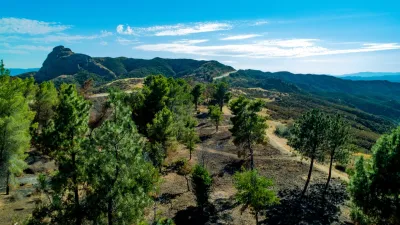Effective wildfire mitigation in California requires a holistic approach that goes beyond large-scale vegetation removal, emphasizing home hardening, defensible space, strategic planning, and reducing human-caused ignitions.

The January 2025 Los Angeles wildfires devastated the region, destroying over 10,000 homes and resulting in more than two dozen fatalities. In response, some have proposed solutions like the "Fix Our Forests Act," which may inadvertently harm California's unique ecosystems without effectively addressing the root causes of such fires. A prevalent misconception is that large-scale vegetation clearing can mitigate wildfire risks; however, experts argue that this approach oversimplifies the complex nature of wildfires in California's diverse ecosystems. Effective solutions require multifaceted, region-specific strategies that consider ecological nuances and emphasize improved urban planning.
California's ecosystems, including mixed conifer forests, oak woodlands, and shrublands, each have distinct fire regimes characterized by variations in frequency, timing, size, and intensity. In Southern California, native shrublands like chaparral and sage scrub are adapted to infrequent, high-intensity fires occurring every 30 to 100 years. Historically, these areas experienced low lightning strike frequencies, resulting in fewer natural ignitions. The plant species in these ecosystems possess adaptations such as fire-induced seed germination and resprouting, enabling rapid recovery after intense fires. However, excessive disturbances, including frequent fires, can negatively impact these ecosystems, underscoring the importance of tailored fire management strategies.
While fuel modification can be beneficial in specific contexts, such as creating defensible space around structures and establishing strategic fuel breaks to aid firefighting efforts, it is not a panacea. During extreme wind events, like those driven by Santa Ana winds, embers can travel significant distances, igniting structures regardless of nearby vegetation management. Therefore, experts advocate for a comprehensive approach to wildfire risk mitigation that includes home hardening, maintaining defensible space, thoughtful community and infrastructure planning, and reducing human-caused ignitions. This holistic strategy aims to enhance community resilience while preserving the ecological integrity of California's diverse landscapes.
FULL STORY: Expert Perspective: Wildland Fuels Management Would Not Have Saved Us from the January 2025 LA Fires

National Parks Layoffs Will Cause Communities to Lose Billions
Thousands of essential park workers were laid off this week, just before the busy spring break season.

Retro-silient?: America’s First “Eco-burb,” The Woodlands Turns 50
A master-planned community north of Houston offers lessons on green infrastructure and resilient design, but falls short of its founder’s lofty affordability and walkability goals.

Delivering for America Plan Will Downgrade Mail Service in at Least 49.5 Percent of Zip Codes
Republican and Democrat lawmakers criticize the plan for its disproportionate negative impact on rural communities.

Test News Post 1
This is a summary

Test News Headline 46
Test for the image on the front page.

Balancing Bombs and Butterflies: How the National Guard Protects a Rare Species
The National Guard at Fort Indiantown Gap uses GIS technology and land management strategies to balance military training with conservation efforts, ensuring the survival of the rare eastern regal fritillary butterfly.
Urban Design for Planners 1: Software Tools
This six-course series explores essential urban design concepts using open source software and equips planners with the tools they need to participate fully in the urban design process.
Planning for Universal Design
Learn the tools for implementing Universal Design in planning regulations.
EMC Planning Group, Inc.
Planetizen
Planetizen
Mpact (formerly Rail~Volution)
Great Falls Development Authority, Inc.
HUDs Office of Policy Development and Research
NYU Wagner Graduate School of Public Service




























